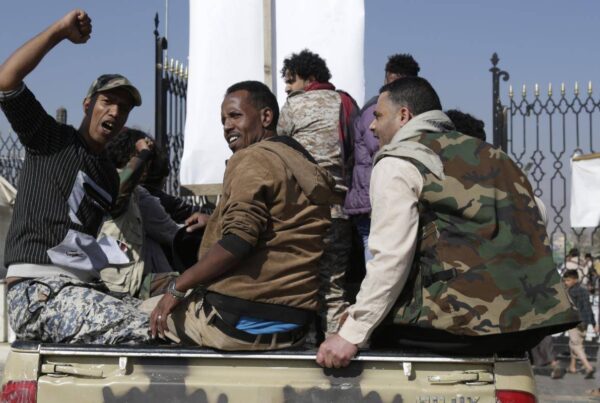By seizing Sanaa and its security apparatus, the Iran-linked Houthis have imposed a new political reality in Yemen. But to secure their influence, they will eventually need to seek accommodation with Saudi Arabia.
In late September, the Houthi movement—an Iran-linked militant Islamist group belonging to the Zaidi Shia sect—took control of Sanaa. By seizing Yemen’s capital and its security apparatus, the Houthis have imposed a new political reality.
At first glance, Saudi Arabia appears to be the biggest loser of this shift, as a Saudi-sponsored order succumbs to growing Shia and Iranian influence on its southern border. But Saudi Arabia’s influence in Yemen is such that no matter what group controls Sanaa, it will have to deal with Riyadh one way or another. In the end, both the Houthis and the Saudis themselves may seek an understanding based on certain mutual interests and a realistic appraisal of the limits of unilateral action in Yemen.
Breakdown of the Saudi-Backed Order
The Houthi takeover represents a challenge to the order established by the Gulf Cooperation Council, or GCC—a Saudi-dominated body gathering the states of the Arab Peninsula except Yemen.
Signed in November 2011 to extricate Yemen from its post-Arab Spring crisis, the political roadmap known as the GCC initiative was backed by all member states except Qatar. Since then, the GCC initiative has been the cornerstone of Yemen’s political order. Its primary objective was to end the impasse begun after the Arab Spring protests of 2011 by putting an end to the rule of Yemen’s long-time president Ali Abdullah Saleh. The deal provided Saleh with legal immunity and a safe exit from the presidency in November 2011, as he transferred power to his deputy Abd-Rabu Mansour Hadi, who then succeeded him as Yemen’s president. The initiative also included an ambitious plan to reconstruct the military and put an end to divisions within the military units, but this turned out to be easier said than done.
The Houthis, who have been in open rebellion against Yemen’s central government for years, originally rejected the initiative. Later, they would indirectly accept it and begin to reintegrate themselves with Yemen’s political landscape by participating in the nine-month long National Dialogue Conference that started in March 2013 and was launched as a consequence of the GCC initiative.
While the international community still endorses the GCC initiative for Yemen, the Houthi takeover of Sanaa in September 2014 has put an end to the political system it helped create.
The Houthi power grab in Sanaa resulted in a deal with Hadi’s central government which concluded in September this year. This so-called Peace and National Partnership Agreement resulted in the toppling of the national unity government and the granting of sweeping security powers to the Houthis, in return for renouncing their sit-ins and armed blockades of the capital.
A Setback for Saudi Influence
On the surface of things, this would seem to be a humiliating defeat for Saudi Arabia, the primary sponsor of the GCC initiative-based order in Yemen, not least because the Saudi government is locked in a fierce regional rivalry with Iran, which is the main ally of the Houthi movement. By mid-October, the Sanaa crisis had unleashed a war of words between Riyadh and Tehran. Saudi Arabia’s Minister of Foreign Affairs, Prince Saud al-Faisal, slammed Iran as a sinister occupying force, saying “if Iran wants to be part of the solution, it needs to withdraw its forces from Syria, Iraq, and Yemen.”
However, the Houthi takeover has not brought a complete reversal of fortunes for the Kingdom. Saudi Arabia still benefits from a long history of official and unofficial influence in Yemen. In fact, Saudi influence is so widely understood to be a permanent feature of Yemeni politics that local actors are prepared to work hard to attract Riyadh’s representatives into an alliance, typically hoping to leverage Saudi support against their own enemies. By contrast, other states will often have to exert far greater effort to be accepted by local political actors in Yemen.
Intriguingly, this also applies to Saudi-Houthi relations. Even though Saudi Arabia intervened militarily in Yemen to wage war on the Houthis as recently as November 2009, the real distance separating Saudi Arabia from the Houthis is smaller than it appears.
Potential for Saudi-Houthi Cooperation
Even though the Houthis follow the so-called Zaidi branch of Shia Islam and Saudi Arabia is committed to the anti-Shia, Wahhabi brand of ultra-orthodox Sunni Islam, their general outlook is in some ways similar.
Both the Houthis and Saudi Arabia share a reliance on theological legitimacy and have little time for the politics of gender equality, pluralism, or human rights. Both have also been pragmatic in their approach to politics in Yemen and have proven themselves perfectly willing to seek alliances across any ostensible Sunni-Shia divide. Historically, for example, Saudi Arabia supported the Zaidi Shia monarchy’s attempt to regain power in North Yemen between 1962 and 1970, despite the difference in confessional and ideological doctrines. And in 1994, Saudi Arabia supported a separatist rebellion in the former South Yemen, even though it was led by former communists and had been an ally of the Soviets before.
For their part, the Houthis are no less pragmatic. When Saudi Arabia added the Houthis to its list of terrorist groups March 2014, the Houthi leader, Abdul-Malik al-Houthi, simply stated that he understood the reasons behind Saudi Arabia’s action but hoped it would review its decision.
There’s also no shortage of common enemies. The Muslim Brotherhood was also listed by Saudi Arabia as a terrorist group. The Houthis regard the Brotherhood as their traditional foe and share Saudi Arabia’s desire to sanction the group. Saudi interests also converge with the Houthis’ on al-Qaeda, which both consider a dangerous threat.
The Houthi surge in Yemen could also impact the Saudi government’s own internal struggle with restive Twelvers, a branch of Shia Islam and a minority in northeastern Saudi Arabia, which harbors movements opposed to the royal family, some of them linked to Iran. The Saudi response to recent events in Yemen must therefore be carefully calibrated and based on mutual interest rather than sectarian prejudice. If mishandled, it could inflame the Sunni-Shia tension that already undermines stability both in Yemen and in eastern Saudi Arabia, not to mention in Bahrain and other places of concern to the Saudi government.
Houthi Interest in Defusing Conflict
The Houthis are now in a position of strength, but to secure their influence they will eventually need to seek accommodation with Saudi Arabia. Not only do the Saudis control the border to the Houthi movement’s core areas in the north, the Houthis’ recent gains are not quite as decisive as they may seem. Yemeni politics have always been profoundly local. Holding Sanaa will not necessarily enable the Houthi leadership to dominate the rest of the country, nor help it shield itself from challenges originating in other areas of Yemen.
In fact, had Sanaa been as important for the rest of Yemen as some observers seem to think, the Yemeni government—which previously controlled the city—should have had more influence outside the capital. As events have proven, that was not the case, and the government was unable to protect itself against the rise of a regional competitor like the Houthis. Unless the Houthis manage to negotiate a modus vivendi with their Yemeni and non-Yemeni rivals, history could repeat itself.
However, the growing influence of the Houthis in northern Yemen should not be disregarded, especially as their behavior gets more reckless and violent. The Houthis’ management of power is working against them. Houthis have attempted to seduce the public by getting rid of the old guard, but their image in Yemen now is that of a newer force that has supplanted a less popular one, only to take its place. That’s something Saudi Arabia will need to bear in mind when thinking “what’s next” in Yemen.
No matter the results of the complex internal and regional dynamics, the Peace and National Partnership Agreement which concluded in September 2014 has now paved the way for a new round of bids and tenders for influence in Yemen by Saudi Arabia, Iran, and other regional actors. In the end, re-stabilizing a unified Yemen should remain an important goal for Saudi Arabia, which is deeply concerned by the sectarian and political chaos on its southern border. This goal cannot be achieved with the Houthis in sole power, but it is time to realize that it also cannot be achieved without the Houthis as a part of the equation.








